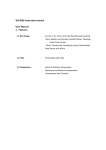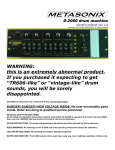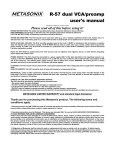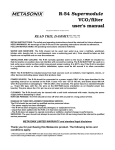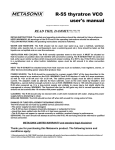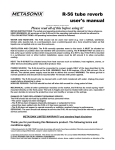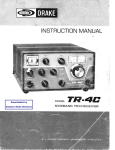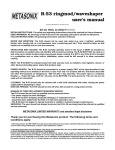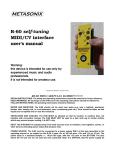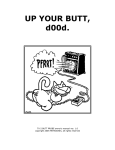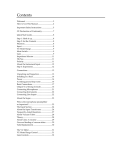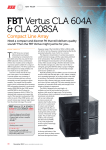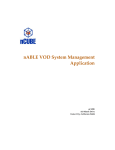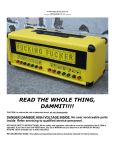Download READ THE WHOLE THING, DAMMIT!!!!
Transcript
D-1000 drum machine owner's manual ver. 1.0 by Brian Kirby and Eric Barbour, copyright 2010 METASONIX, all rights reserved READ THE WHOLE THING, DAMMIT!!!! CAUTION: to reduce the risk of electrical shock, do not disassemble. DANGER! DANGER! HIGH VOLTAGE INSIDE. No user serviceable parts inside. Refer servicing to qualified service personnel. DETAILED SAFETY INSTRUCTIONS: All the safety and operation instructions must be read before the D-1000 is operated. If you don't read and HEED them, you are a MORON and you deserve to be EATEN BY YOUR MOTHER'S PENIS. RETAIN INSTRUCTIONS: The safety and operating instructions should be retained for future reference. HEED WARNINGS: All warnings on the D-1000 and in the operating instructions should be adhered to. FOLLOW INSTRUCTIONS: All operating instructions should be followed. WATER AND MOISTURE: The D-1000 should not be used near water (e.g. near a bathtub, washbowl, kitchen sink, laundry tub, in a wet basement, near a swimming pool etc., ya stupid bastard). Care should be taken so that liquids are not spilled onto or near the enclosure. VENTILATION AND COOLING: The D-1000 normally operates VERY warm to the touch. It MUST be situated so that its location or position does not interfere with convective cooling. The D-1000 MUST NOT be used on a bed, sofa rug or similar surface which may prevent proper cooling. It is NOT a toy, AND IT IS NOT A DILDO. If the D-1000 is mounted in a rack or other built-in installation, space must be left around it to allow convection from the case. HEAT: The D-1000 MUST be situated away from heat sources such as radiators, heat registers, stoves, or other devices (including power amps) that produce heat. We DO NOT recommend leaving the D-1000 powered up with the cabinet lid closed. POWER SOURCE: The D-1000 should be connected to an AC-AC adapter power supply ONLY of the type marked on the D-1000 panel. DO NOT try to feed it with DC power. AC ONLY!! POWER CORD PROTECTION: Power supply cords should be routed so that they are not likely to be walked on or pinched by items placed upon or against them. Don't burn your house down, child molester. CLEANING: The D-1000 should only be cleaned with a soft cloth moistened with water. Unplug the power supply before attempting to clean. NON-USE PERIODS: The power inlet of the D-1000 should be unplugged from the outlet when left unused for a long period of time. DAMAGE OR TUBE REPLACEMENT REQUIRING SERVICE: The D-1000 should be serviced by qualified service personnel when: -The D-1000 has been dropped, physically damaged, or subjected to force; -Liquid has been spilled onto the D-1000 or it has been exposed to rain; -The D-1000 does not appear to operate normally or exhibits a marked change in performance. SERVICING: The user should NOT attempt to service the D-1000. All servicing should be referred to qualified service personnel. METASONIX LIMITED WARRANTY and standard legal disclaimer Thank you (whatever, meh) for purchasing this Metasonix product. The following terms and conditions apply: 1. Warranty period is for one year from date of purchase with proof of purchase submitted. Warranty covers electrical failure of vacuum tubes and gas-filled tubes, except in cases explained in 3 below. 2. Operating instructions must be followed. This device was intended ONLY for use by AUDIO AND MUSIC PROFESSIONALS. IT IS NOT INTENDED FOR USE BY ORDINARY CONSUMERS!! Product must not have been damaged as a result of defacement, misuse, abuse, neglect, accident, destruction or alteration of the serial number, improper electrical voltages or currents, repair, alteration or maintenance by any person or party other than our own service facility or an authorized service center, use or installation of non-Metasonix replacement parts in the product, or the use of this product outside of the U.S.A. or Canada, or modification of the product in any way, or incorporation of the product into any other products, or damage to the product caused by accident, fire, floods, lightning, or acts of God, or any use violative of instructions furnished by Metasonix. It is also not intended for use as a condom-warmer. 3. Obligations of Metasonix shall be limited to repair or replacement with same or similar unit, at our option. To obtain repairs under this warranty, present the product and proof of purchase (e.g. bill or invoice) to the authorized Metasonix service center, transportation charges prepaid. When returning the product for repair, please pack it very carefully, preferably using the original packaging materials. Please also include an explanatory note. IMPORTANT: To save yourself unnecessary cost and inconvenience, please check carefully that you have fully read and followed the instructions in this instruction manual. This warranty is in lieu of all other expressed warranties, obligations or liabilities. ANY IMPLIED WARRANTIES, OBLIGATIONS, OR LIABILITIES, INCLUDING BUT NOT LIMITED TO THE IMPLIED WARRANTIES OF MERCHANTABILITY AND FITNESS FOR A PARTICULAR PURPOSE, SHALL BE LIMITED IN DURATION TO THE DURATION OF THIS WRITTEN LIMITED WARRANTY. Some states do not allow limitations on how long an implied warranty lasts, so the above limitations may not apply to you. IN NO EVENT SHALL WE BE LIABLE FOR ANY SPECIAL, INCIDENTAL OR CONSEQUENTIAL DAMAGES FOR BREACH OF THIS OR ANY OTHER WARRANTY EXPRESS OR IMPLIED, WHATSOEVER. Some states do not allow the exclusion or limitation of special, incidental or consequential damages, so the above limitation may not apply to you. This warranty gives you specific legal rights, and you may also have other rights which vary from state to state. METASONIX shall not be held liable for any incidental, consequential, or direct damages or expenses associated with the use or misuse of the D-1000. The audio output of the D-1000 is capable of damaging some types of solid-state audio equipment; such use is entirely at the risk of the user. METASONIX does not guarantee that any of its products are designed for any particular use or purpose. The entire risk of suitability and performance of this product lies with the user. Products manufactured and/or sold by METASONIX are not authorized for use as critical components in devices used in life support and other systems whose failure or performance could result in compromised safety or danger to life or property. Don't perform surgery with a D-1000. It has no healing magic, and might have deleterious effect on gonads. Did we mention the DANGEROUS HIGH VOLTAGES inside the D-1000? DO NOT OPEN THE D-1000 unless you're a service technician. NOTE: All sales are FINAL, especially custom designs. Only a Metasonix authorized dealer is permitted to return products to Metasonix for a refund or exchange. WHAT IT DOES The D-1000 is NOT a Linndrum or sample playback device! Do not expect it to sound or behave like a drummer! Do not expect it to sound or behave like a machine trying to sound like a drummer! Do not furiously twist the knobs in search of the 1980s gated reverb snare sound! Fuck you and fuck the 1980s! Oh, and PS: there are no presets! So, let's put it in terms even a musician can absorb. Think of the D-1000 as a primitive box containing 4 screaming children, being punched in the throat to the rhythm of the internal sequencer or user supplied (this means you!) pulse sequence source. These screaming voices are generated by the 6CQ8 tubes that are staring at you right now (you do like to read the manual while you have the unit in front of you...............right???...................) The knobs control the amount of strangle of the screaming voices. Turn them to the right for higher pitched screams, and turn to the left for a tighter strangle and more choking. They make the TR-606 sound like a simpering twat tapping on tin cans. The rows of switches on each voice are the sequencers. Eight switches, one measure of eight beats. Flip a switch up to trigger a punch in the throat at that beat, flip down for silence. In addition to screaming belches, these voices can accept audio signals that will swallow your signal and excrete out a nice bandpass filtered variation of what you stuck inside. This is done by slamming audio into the Trigger In jacks. The Trigger In jacks also accept a pulse (punch in the throat) to trigger the screams. The CV Ins are there to add chaos to the screaming orchestra. These voices are then fed to the overdriveable mix output and to the individual audio outputs for each voice, both simultaneously. Use the roll button to replace a punch in the throat with a jackhammer to the throat. Why do other drumboxes have stupid little buttons that trigger only one drum-punch? We like a good beating, so our buttons administer repetitive pain. HOW TO SET UP AND USE The D-1000 needs 12 volts AC power at 1.5 amps. DO NOT attempt to power it with DC, you will DAMAGE IT AND THE POWER SUPPLY. DO NOT experiment with random AC adapters. Use only a Jameco 167151 adapter in the USA or other countries that have 100-120v power. (If you are in a country with 220-240v power, use a Maplin L54BR or similar adapter only. The power connector is a 2.1mm coaxial type.) Connect the main audio output (the 1/4" jack that pokes out of the D-1000 panel) to an amplifier or PA, set ALL the knobs on the D-1000 to MIDPOSITION, and turn on the D-1000 power switch. You should see the two LEDs on the panel flashing at different rates. (The tubes might glow visibly, or they might not. Do not whine at us that the D-1000 is "broken" if you can't see the tube glow. The only way to know the D-1000 is working properly is to hear sound out of every drum circuit.) Start out by setting all the switches down, CV level and tune knobs in the center at 12 o'clock, mix level wherever in the hell sounds best to you, Cymbal attack to 4 o'clock, and final mix output level at 12 o'clock. Run the main mix output into your amp, DI or line input of choice. Set the RUN switch to the left. Flick the first switch up on Drum 1. Congratulations! You have just punched voice 1 in the throat! Listen to the nice, bloody result. Now flick switches 3, 5, and 7 up. Now you have the foundation of a basic beat. Adjust the tempo to your liking with the Main Beat Clock Speed knob. Experiment with the tune and CV level knobs until a desired low end rumble is achieved. These knobs are very sensitive and the slightest movements alter the pitch greatly, so turn them slowly. (Why do they have so much excess range? Because we have to allow for tube aging. All the controls on all our products are like this. Vacuum tubes are not your friends, and they are not "convenient".) Hold down the Drum 1 Roll button. Congratulations, you have just jackhammered voice 1 in the throat! Now hold down the Roll button and adjust the tune knob. Is that an easier way to tune the voice? Hear the filter sweep range? Listen to the screaming angry child as he is jackhammered in the throat. Get it out now, feels good. Now on Drum 2, flick switches 2, 4, 6 up and repeat the same process until you have a nicely tuned gallop. Flick switch 7 up on the Snare voice and repeat the process until you reach the desired pitch for a snare or finger snap (or whatever crap you want it to sound like). Flick switches 2, 4, 6, and 8 up on the Cymbal voice. Experiment with the Attack knob, get to know it. Yes, the Attack knob is weird. Turn it too far to the left, and you won't hear the cymbal. (It's a VERY primitive circuit.) You may find it more interesting to use the separate Cymbal output and process the cymbal through a reverb or other effects. The Cymbal voice is generated by the noise created by a zener diode combined with the high gain of the output tube. Say again, primitive. Flick switch 3 up on the Snare voice so that both switch 3 and 7 are on, thus generating a steady beat. Increase the tempo. Increase the mix output level and overdrive the preamp. Tune the Snare pitch low and listen to the gabber. Now stop thinking of the Snare voice as a snare and tune it to a thumpy kick in the stomach. Bela Lugosi's dead......dead......dead.......and we're kicking his corpse, ha ha. Guess what, you can stop the D-1000 sequencer with the RUN switch. No shit. Let's get more advanced, with patch cords and stuff!! Now stop using the Cymbal as a cymbal, use it as a snare. Patch the Cymbal Out into the KV-100 or similar noise-floor increasing device. Lock your doors, call in sick to work. Now ..... patch your favorite random voltage generators and LFOs into the various CV inputs. You use those teeny tiny Eurorack module thingies, right??? Try a slow ramp wave into Drum 1 CV input. Try a sample-and-hold into the Snare voice. (Try that little trick with a stinking TR-606. Hah.) Hold down the roll switch and listen to jackhammers bubble through flesh. Bubble, bubble, drip, drip................ Pick a sequencer with a clock input. Now slave it to the D-1000 using the main beat clock out. Feed the sequencer outputs to the D-1000's CV inputs. Hold the roll button and listen to the dripping. Don't complain about the D-1000's limited sequencer! There are trigger inputs for each voice, allowing you to ram your own 0-5v pulses into them. Pick a clock from the zillions of clock-generating options made by various analog synth modules, then feed it to a pulse divider. Feed divided outputs into each D-1000 trigger in. Build a rhythm. Feed individual drum audio outputs into a voltage controlled mixer or into a mixer with a VCA before each channel. Feed mixer output into your Metasonix R51 module. (Don't have one? Curse you!) Now modulate the mix of each D-1000 voice in the voltage controlled mixer with your obscure random voltage generators .... enjoy the crunch of the R51, play it loud ...... Try adding your KV-100 for even more mayhem. (You do have a KV-100, yes?) Turn the sequencer off by flipping all the switches down or unplug your external clock source(s). Patch the R54 or whatever oscillator you want to use into the snare voice trigger in. This will be passing the R54 as audio into the filter of the snare voice. (Why don't you have an R54??) Patch the D-1000 main beat clock out into the clock input of your sequencer of choice. Feed sequencer into the R54 pitch CV. Flick drum voice 1 switches 1, 3, 5, and 7 up and tune it to your liking. Twist the tune knob of the snare and feel the snarl of the bandpass filter. Drum 1 functions as a drum while drum 2 and snare(or any combination you want) can be used for filtering. Now overdrive the preamp by increasing the mix output level. Increase the D-1000's master tempo. Patch a slow LFO sweep into the snare voice CV. Now increase the LFO to audio rates. (If the above doesn't give you some ideas on how to apply your shiny D-1000, you are a pathetic snot-eating troll. And I can't help you anymore.) MAINTENANCE WARNING: If you aren't familiar with the innards of tube electronics, DO NOT OPEN THE D-1000. It is a VERY complex device. BE CAREFUL removing the chassis from the tackle box. The D-1000's tubes used are no longer made. Fear not. All these tubes are VERY commonly available in great quantities in NOS form, and not available from your friendly guitar dealer. Try Antique Electronic Supply (www.tubesandmore.com) or Radio Electric Supply (www.vacuumtubes.net). The D-1000 uses four type 6CQ8 tubes. 6GH8, 6U8, 6AX8 or 6EA8 should work. 6BL8s might work. NO, 12AX7s WILL NOT WORK!!! When replacing the tubes, you should readjust the resonance trimpots on the bottom of the D-1000 board. ADJUSTING RESONANCE: The Drum 1, Drum 2 and Snare circuits are based upon ringing filters. In order to get the best resonant drum tone, it might be necessary to adjust the resonance of these circuits. To access the bottom of the board: 1) TURN OFF POWER to the D-1000. 2) Close the lid and turn the tacklebox over. The chassis is held in the tacklebox by the four screws inside the rubber feet on the bottom. CAREFULLY remove those screws. Be careful that the chassis does not drop inside the tacklebox, as this might break a tube. 3) Carefully remove the chassis. You will see four trimpots on the bottom of the board. 4) You will see FOUR trimpots on the bottom of the PC board. Three of them control the resonance of the filters that make up the Drum 1, Drum 2, and Snare voices. The fourth one controls the speed of the Roll clock generator. 5) Power up the D-1000 and monitor amp, so you can hear the D-1000 sounds. (BE CAREFUL, there are high voltages on the PC board!) 6) You will need a small flat-blade screwdriver to adjust the screws on the trimpots. Start by holding down the Roll button on Drum 1, and setting its pitch to about the 10-o'clock position. You should hear the drum roll. While holding done the Roll button, adjust the trimpot nearest the Drum 1 controls (leftmost on the PC board) counterclockwise until you hear the desired resonant "thud". (Be careful! Turning the trimpot too far will cause the filter to howl, as it oscillates. Just set it carefully to the right amount of resonance. Adjust the tuning knob to insure you get a good, resonant sound with no howling.) 7) Repeat 6 above, on the Drum 2 voice, then on the Snare voice. Note that the Snare sound is a little different from the others. 8) If you wish to adjust the Roll clock, its trimpot is near the Roll LED. Hold down any Roll button and adjust the trimpot for desired drum-roll speed. The tubes are being run conservatively, and should last for many, many years. Do NOT listen to guitar amp “tech gurus”. They know very little, and have never seen this circuit before. Check with us BEFORE YOU DO SOMETHING STUPID. Thank you. The D-1000 use a low-voltage "polyfuse" self-resetting fuse. It is soldered to the PC board, and should not need replacement. If the polyfuse opens repeatedly, you are probably feeding the D-1000 too much AC power voltage, or you are stupidly trying to feed it DC power. Use ONLY the AC-AC adapters we recommend to power the D-1000. DO NOT EXPERIMENT!! OTHER CRAP Audio outputs: 1000 ohm unbalanced, suitable to drive 600-ohm inputs, maximum level +20dBm. CV inputs: maximum range -5v to +5v DC. Usable sweep depends on settings of CV Level and Tune controls. CV Level and Tune controls for each voice interact with each other. All controls may interact with unrelated controls slightly. Individual audio outputs for each drum voice may not be fully isolated from the other voices. CV and trigger pulses are not fully isolated from the outputs. There may be hum, noise and crosstalk on all inputs and outputs -- get used to it. It's an extremely primitive drumbox, and if you don't like that, we can only say: why did you buy the damned thing, and then we say, send it back immediately, we have plenty of other customers who want one. Then you are welcome to return to your first love: sucking the paint off your precious TR-606. “Retarded Animal Babies” Cartoons ©2010 David C. Lovelace, all right reserved. Thanx man! Check out Dave's horrendously offensive animations at umop.com (text is copyright 2010 Metasonix. All rights reserved. It is a violation of federal law to reproduce, reuse or duplicate this publication without the express written permission of Metasonix or its assigned representative.) (Oh, you want to FIX it? You say you want a SCHEMATIC?? Oh, that's PRICELESS. Contact us at METASONIX. 870 S. Main #109, Lakeport CA 95453, (707) 263-5343, [email protected]. We'll arrange for repair, while refusing to give you a schematic. The circuit of this bastard thing is so embarrassing, we didn't write it down anyway.)








